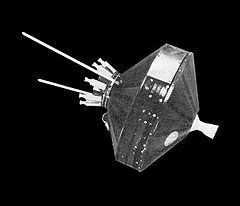Mission type Lunar orbiter Launch site Cape Canaveral LC-17A Launch date 17 August 1958 | Launch mass 83.8 pounds (38.0 kg) Apogee 16,000 m Rocket Thor-Able | |
 | ||
Mission duration 73.6 secondsFailed to orbit Manufacturer TRW Space Technology Laboratories Similar Pioneer 1, Pioneer 2, Pioneer 3, Pioneer 4, Lunar Orbiter 5 | ||
Pioneer 0 (also known as Thor-Able 1) was a failed United States space probe that was designed to go into orbit around the Moon, carrying a television camera, a micrometeorite detector and a magnetometer, as part of the first International Geophysical Year (IGY) science payload. It was designed by the United States Air Force (USAF) as the first satellite in the Pioneer program and was one of the first attempted launches beyond Earth orbit by any country, but the rocket failed shortly after launch. The probe was intended to be called Pioneer (or Pioneer 1), but the launch failure precluded that name.
Contents
Spacecraft design
The spacecraft consisted of a thin cylindrical midsection with a squat truncated cone frustum of 6.5 inches (17 cm) high on each side. The cylinder was 29 inches (74 cm) in diameter and the height from the top of one cone to the top of the opposite cone was 76 cm. Along the axis of the spacecraft and protruding from the end of the lower cone was an 11 kilograms (24 lb) solid propellant injection rocket and rocket case, which formed the main structural member of the spacecraft. Eight small low-thrust solid propellant velocity adjustment rockets were mounted on the end of the upper cone in a ring assembly which could be jettisoned after use. A magnetic dipole antenna also protruded from the top of the upper cone. The shell was composed of laminated plastic and was painted with a pattern of dark and light stripes to help regulate temperature.
The scientific instrument package had a mass of 11.3 kilograms (25 lb) and consisted of:
The spacecraft was powered by nickel-cadmium batteries for ignition of the rockets, silver cell batteries for the television system, and mercury batteries for the remaining circuits. Radio transmission was on 108.06 MHz, a standard frequency used by satellites in the International Geophysical Year, through an electric dipole antenna for telemetry and doppler information and a magnetic dipole antenna for the television system. Ground commands were received through the electric dipole antenna at 115 MHz. The spacecraft was to be spin-stabilized at 1.8 revolutions per second, the spin direction approximately perpendicular to the geomagnetic meridian planes of the trajectory.
Launch and failure
Pioneer 0 was launched on Thor missile number 127 at 12:18:00 UTC on August 17, 1958 by the United States Air Force, only 4 minutes after the scheduled launch time. It was destroyed by an explosion of the first stage of the Thor booster, 73.6 seconds after lift-off at 16 kilometres (9.9 mi) altitude, 16 km downrange over the Atlantic Ocean. The failure was suspected to be due to a turbopump bearing that came loose, causing the liquid oxygen pump to stop. The abrupt loss of thrust caused the Thor to lose attitude control and pitch downward, which caused the LOX tank to rupture from aerodynamic loads and resulting in complete destruction of the launch vehicle. Erratic telemetry signals were received from the payload and upper stages for 123 seconds after the explosion, and the upper stages were tracked to impact in the ocean. The original plan was for the spacecraft to travel for 2.6 days to the Moon at which time a TX-8-6 solid propellant motor would fire to put it into a 29,000 kilometres (18,000 mi) lunar orbit which was to nominally last for about two weeks. Air Force officials stated that they were not surprised at the failure, adding that "it would have been more of a shock had the mission succeeded".
It was the only mission in the Pioneer program carried out by the United States Air Force, as subsequent missions were conducted by NASA.
